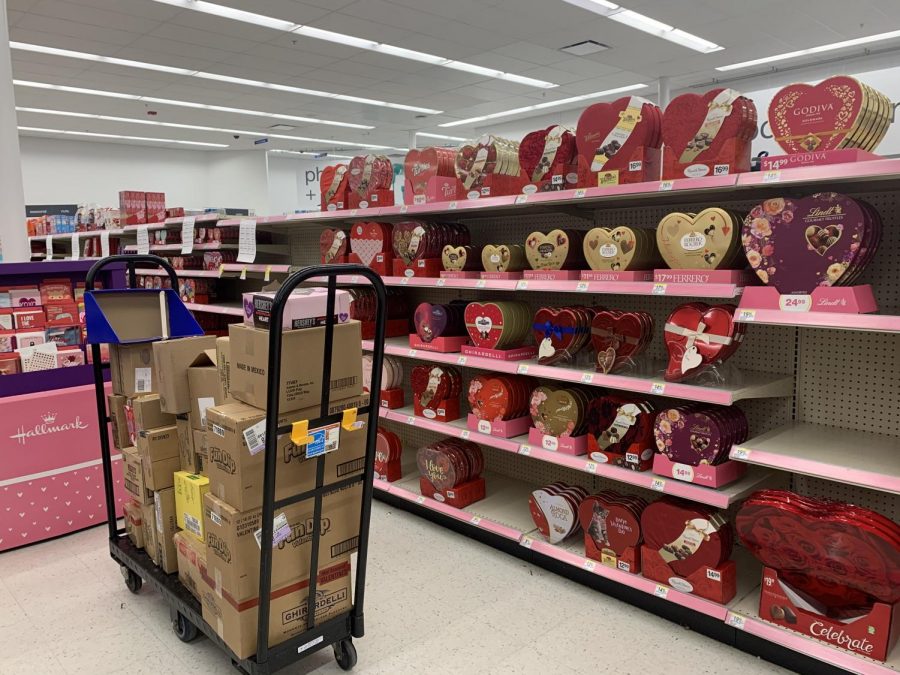Valentine’s Day: not so sweet for the environment
Photo Courtesy of Victoria Park.
The Walgreens in Potomac Woods Plaza has begun stocking the iconic chocolate heart boxes of Valentine’s Day. Most of this chocolate will not be bought or eaten, and as displayed by the pile of boxes on the cart, creates waste. The quantity of candy available in early January also prompts thought on the fossil fuels necessary to make all of these products and transport all of them to thousands of stores throughout the country.
February 3, 2020
There is no better way to show how much you love someone than presenting them with a bouquet of roses, a heart shaped box of chocolates and a plush teddy bear. But these flowers die in a week or so, the chocolates are left half-uneaten and the teddy bear gets shoved into a closet corner never to be seen again. As the earth increasingly suffers from human materialism and wastefulness, everyone should be opting for more eco-friendly declarations of love this Valentine’s Day.
Valentine’s Day in America became a commercial business in the 1800’s starting with cardmaking, which soon expanded into flowers, candies, plushies and jewelry. Cultural obsession with extravagant displays especially in the 21st century has encouraged people to spend more and therefore waste more.
Flowers are one of the main contributors to the environmental degradation that occurs every year due to the high costs needed to harvest , transport and preserve them.
According to the International Council on Clean Transportation (ICCT), flying the billions of flowers Americans purchase each year from South America burns around 114 million liters of fuel and emits approximately 360,000 metric tons of carbon dioxide in 2018.
WCHS students who are especially active in environmental awareness should not purchase cut flowers unless they were locally grown. Those who feel remorse for the wildfires in Australia should know that by supporting the cut flower industry, they are helping global warming escalate which causes such environmental disasters.
Instead of just sharing on social media, everyone can help limit waste by not buying flowers at all, picking their own flowers, buying potted plants or looking for locally grown and in season flowers. Websites such as Slowflowers.com show where you can support local businesses that do not use excessive energy to grow out of season roses and still get a beautiful bouquet.
Another contributor to environmental destruction is the mass consumption of chocolate. According to World Wildlife Fund (WWF), producing the cacao seeds needed for chocolate has caused deforestation in Africa, South America and Asia and will lead to the mass extinction or endangerment of local wildlife such as primates. Particularly in Africa, where most of the world’s chocolate is produced, climate change has started to increase temperatures and slow down cacao tree growth.
Luckily, many ethical alternatives for chocolate that hurts our environment are available. Look for Fair Trade and eco-friendly packaging, such as Vosges Haut-Chocolat, who make sure all their ingredients are sourced from organic, sustainably grown and non-GMO farmers. They have also adopted the Green Purchasing Policy which promises their packaging minimises negative environmental impacts over their life cycle of manufacturing, transportation, use and recycling or disposal.
Jewelry, particularly diamonds and gold, are not only environmentally deteriorating but also ethically questionable. According to Earthworks, a nonprofit made for environmental protection, one gold ring creates 20 tons of waste. The machinery needed to mine for gold also erodes natural landscapes and leaks harmful chemicals into water supplies.
Diamond mining has similar impacts in regions where it is mined, especially in Africa where mining is often unregulated. This leads to soil erosion, deforestation and the disruption of ecosystems. The Green Diamond states that 1,750 tons of soil must be extracted to find a single 1.0 carat rough diamond. Machinery needed to dig diamonds out, clean the diamonds, refine the diamonds, transport the diamonds, pump CO2 into the air and creates even more waste.
Buying new jewelry from large retail stores or chains is supporting an industry that does not care about its environmental impacts at all. By changing the way your money is spent, the more influence you have in saving our planet. It is also fairly easy to buy jewelry ethically. Purchase vintage pieces or buy jewelry made from recycled materials or sources that are verified to be environmentally regulated.
Modern day emphasis on being eco-friendly is pointless if Americans continue making wasteful purchases that support various industries that have no regard for the environment. Although recycling is important, the “reduce and reuse” parts must become more important and implemented. If everyone stopped buying things they don’t necessarily need or will not use, our planet would suffer less. This Valentine’s Day, make sure to be conscious of every gift you buy for your loved ones. Ethical and environmentally friendly sourced and made food, flowers and jewelry are easier to find than you may believe. Make Earth your Valentine’s this year.


